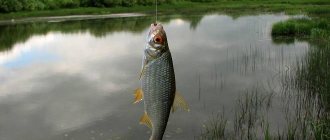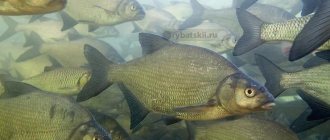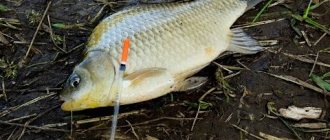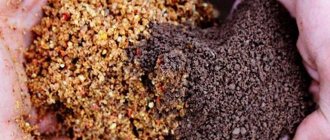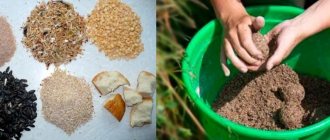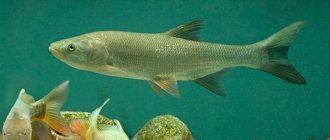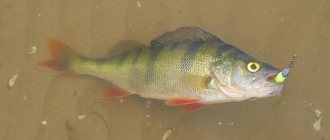Fishing in open water in November is not easy, because this is the pre-winter period, not winter or autumn: it will either be frosty or warmer. The pressure changes sharply, which is accompanied by gusty cold winds. The average daily air temperature steadily drops below zero. The days are getting even shorter. Most underwater inhabitants are not very active.
The predator has already been mostly satiated and has accumulated the necessary reserves for wintering. Large representatives of cyprinids have gathered in huge schools in wintering pits, from where it is not so easy to get them from the shore, and the ice in such places will become stronger for a long time.
Fish biting in November
In general, the metabolism of fish slows down as the water gets colder, and with it the appetite decreases. Fishing with rods, hooks and spinning rods is becoming less and less successful. The fish and fishermen seem to be waiting for the pond to become frozen with ice. And ice fishing will begin with more elegant winter gear using jigs, balancers and girders.
The first ice appears on lakes, ponds, small rivers and bays without a current. Ice fishing lovers are looking forward to this moment. They are often in a hurry, go out onto the fragile ice shell and open the winter swimming season. Although the Ministry of Emergency Situations warns fishermen every year, the excitement of the long-awaited fishing is stronger. Sometimes it ends tragically. Please follow basic safety rules, do not go out on thin ice, have rescue equipment and a reliable friend nearby. Don't go out on the first ice alone.
You should start fishing from ice only when its thickness reaches at least 5–6 cm, and preferably 10 cm. In this case, you must always be careful. You cannot take a single step forward without first checking the strength of the ice, especially on rivers and reservoirs with currents and underwater springs.
Start the winter season with small lakes and calm rivers, where the ice gets stronger faster. And only with the onset of severe frosts can you go out to large bodies of water. This happens in late November - early December. You can start the winter season by fishing from platforms and piers, without waiting for the reservoir to be covered with ice.
Spinning fishing in November
November is quite a good month for spinning fishing. The predator is fattening. The probability of catching a trophy pike, pike perch or perch is quite high. In November, it is worth using large spinning baits and feeding them to the fish with a slow retrieve, since as the water gets colder, the fish’s activity has decreased.
The fishing location should be selected taking into account the fishing object. If you catch perch with a spinning rod in November, then at this time it often stays in shallow areas, among the remains of underwater vegetation and snags. To catch it, it is better to use medium-sized baits. Perch is rarely caught using large baits in November, although the size of this perch is often impressive.
Predators such as pike and pike perch stay near deep holes in November. To catch them, large spinning baits should be used. In November, large-sized pike and pike-perch are often found, and every angler has the opportunity to catch his own trophy.
The predator is fattening and picking up a catchy bait becomes much easier. Try fishing with large wobblers, spoons and silicone.
Perch fishing in November
In shallow places, next to vegetation that has not yet died off, a small “sports” perch is always caught using a jig with a bloodworm attachment. Fish, especially perch, often gather on the first ice in shallow places near the grass. This is the most suitable place for fishing. But here you should also be careful: where there are a lot of frozen plants, the ice is a little weaker.
A classic winter balalaika fishing rod, the thinnest fishing line and a small jig with bloodworms will quench the accumulated itch in the fisherman’s hands.
It is advisable to catch larger perch using modelless baits, tempting the fish with a skillful game. Priority is given to nail cubes, nail balls, as well as goats and devils. On the first ice, while there is still a sufficient amount of oxygen in the water, fishing with reelless baits is especially successful.
Well, it’s advisable to hunt for the largest rounds with a balance beam, combing deep-sea snags and dumps. In reservoirs, promising habitats for large perch are navels.
Pike fishing in November
In November, pike hide in snags next to deep holes, where they need to be caught. For active pike fishing at the beginning of winter, large balancers or vertical spoons are suitable. Do not forget to pause after swings, change the pace of the retrieve and be sure to install a steel leash.
Fishing for pike using girders on the first ice is very productive. Install them near shelters, on the border of changes in terrain. Always place the baits at different depths, looking for an active predator. Record the depths at which most bites occur today and move all the “flags” to this line.
Small pike live near vegetation in relatively shallow areas of the reservoir. To catch it, they use small spinners, or large jigs, “pisdriki” type decoys, reminiscent of small fry, which are tied to a fluorocarbon leash.
Fishing at the end of November. Exit to First Ice
Entering the first fragile ice is associated with danger, so fishing stops until the thickness of the ice crust on the reservoir reaches 7 cm.
But even then the fisherman needs to be extremely careful, not to take a step without first checking the strength: perhaps, in this place, the ice crust has been washed away by warm underwater springs or heated by the sun.
After freeze-up, fishermen take out winter gear - almost all types of fish can be caught well on the first ice.
Perch and Roach will be caught on a jig with a moth, near sunken snags and grass thickets. Place a perch eye, worm or bloodworm on the hook and you will catch an average perch at shallow depths.
Large fish, such as Pike perch, large perch, and pike, must be caught with large winter lures.
Pike traditionally goes well with live bait. You should look for it in the Depth;
For float rods - Guster, Sand, Ide, Chub, Roach, Bream and even Perch;
By casting a bottom fishing rod with bait in the form of Chicken Guts or Small Brush, the fisherman will almost certainly catch Burbot.
Fishing during the fishing off-season during the fishing season is practically a win-win option. The only people who won’t fall for it are Sudak and Pike at shallow depths with a steady current.
The ice on the river has frozen, which means we need to have time to fish in the Morning, Lunch and Evening. Pike-perch hunters will have to get up first and go to bed last. This fish bites well early in the morning and in the evening. Dull weather is another essential condition for successful fishing.
The most successful fishing in November occurs on not too frosty, quiet, cloudy days. In the last days of autumn, fish hide in the backwaters of large reservoirs, lakes and ponds.
In general, for a passionate fisherman, the off-season is not a reason to reel in fishing rods. With a skillful approach and due patience, a good catch is guaranteed!
Fishing for pike perch in November
If we compare the pike perch bite during the winter season, it is obvious that fishing for pike perch in November on the first ice is one of the most productive periods. In November, pike perch begins to accumulate near the holes in which white fish stand. You just need to find such a place in the reservoir. In a reservoir, schools of pike perch can migrate behind schools of cyprinids, rather than standing locally at one point. And yet, a good promising snag will almost always be a favorite place for large individuals to stay, both on the river and in the reservoir.
Pike-perch is caught with narrow vertical spoons, hexagon-type spoons, and recently the fashion for catching pike-perch with vibes (rattlins) has become established. In any case, all of the above should be present in the box of an experienced court fisherman. Pike perch can be very picky, not only about the presentation of bait, but even about its color. Make pauses of different lengths, change the amplitude and sharpness of the pull-ups - look for the ideal pull-through for a particular day.
On bodies of water that have not yet frozen, they continue to catch fanged fish using a spinning rod, both from the shore and from a boat. The priority baits in cold water are mandulas and foam fish. Sharp wiring should not be done. Often the pike perch bites when you barely noticeably drag the bait along the bottom, raising the turbidity, or take long pauses. In any case, you should always experiment with bait presentation; in late autumn you should pay special attention to this.
What fish to catch in November
November pike
In fact, quite a lot of fish species are caught in November, although most of them, of course, noticeably lose their activity.
The predator is most active in November:
- pike;
- zander;
- perch;
- bursh;
- burbot.
You can also catch the following fish:
- Bream;
November bream; - Bleak;
- Ide;
- Ruff;
- Gudgeon;
- Chub;
- Guster;
- Dace;
- Roach;
November pike perch
In November it is very rarely caught or does not show activity at all:
- crucian carp;
- Carp;
- Carp;
- Asp;
- Rudd;
- Tench;
- Som.
It is, of course, very difficult to list all the fish, but we have analyzed the main types of fish that are the most popular fishing objects.
If in November the reservoir is already covered with sufficiently strong ice at least 5 centimeters thick, you can go winter fishing on the first ice. First ice is an excellent period for fishermen, when almost all types of fish are caught, especially if the weather is favorable.
Burbot fishing in November
November is a great time to catch burbot. November is exactly the month when you can go after burbot purposefully, since at this time it is most active and willingly takes almost any bait. The main secret to successfully catching burbot is to find its path along which it goes hunting every day. Place traps, supplies, and pokes at depths of 0.5 to 3 meters in a checkerboard pattern. Monitor at what depth the bites occur.
The gear for catching it is the most unpretentious. Burbot has poor eyesight; when searching for food, it relies primarily on its sense of smell. Therefore, you don’t have to worry too much about the thickness of the fishing line. Use live bait. It is believed that ruff is his favorite delicacy; roach and gudgeon are also good options. They catch it with a bunch of crawlings, and even giblets. The smellier the bait, the greater the chance of success.
They also catch burbot in an active way using a plumb line. The bait is called a squealer - it is a large, heavy jig, on which a piece of fish is attached and methodically knocked on the bottom, pausing. Acoustic shocks and fragrant bait do their job.
You should know that burbot is a nocturnal predator; it goes hunting at dusk. It is advisable to plan such fishing trips with an overnight stay in a warm tent.
Choosing a fishing spot, bait and equipment for roach in the fall
Unlike stagnant bodies of water, the river can provide a good catch until the freeze-up period. This is due to the abundant current, which saturates the water with oxygen and makes the fish more active in search of food.
Fishing for roach in November does not involve the most comfortable fishing conditions. An autumn day can be deceptive: the sun may be shining in the morning, but by lunchtime the wind rises and it rains. The fisherman should have the appropriate equipment so that relaxing by the pond does not turn into a severe ordeal.
The choice of place to catch roach depends on the topography of the river . Roaches prefer to stay in deeper places in the fall. You can identify them without the help of an echo sounder. If the bank is steep, then most likely there is a hole underneath it. The ideal place would be fishing at the edge of the reeds with a depth of 2-3 meters. The place should be chosen in such a way that the cold autumn wind does not blow your back.
To catch roach, you can use a Bolognese rod with a blind rig. Catching roach with a fly rod is also appropriate. A float serves as a bite alarm. Roaches very often take the bait on the “layout”, so you should be vigilant and hook when raising the float. The rod should be equipped with an inertial reel; there is no need for more professional models. It has insignificant weight and is perfect for catching small roach. It is better to have a catch with you, especially if fishing involves catching bream.
The fishing line used is thin, up to 0.14 mm. Both animal food (bloodworms, maggots, worms) and plant food (barley, wheat and semolina) are used as bait. Feeding the roach is done initially by throwing 5-10 balls with bait at the fishing point. It is worth noting that autumn feeding should be darkened and contain an animal element.
A budget option for float rigs for roach fishing in the Leningrad region.
Fishing for bream, ide, carp
Large representatives of these species gather in large flocks for the winter. They occupy deep holes with running water and a weak current, and stand in them in dense rows all winter. Cyprinids often choose proximity to colonies of shells and pearl barley, which provide their food in winter.
While the reservoir has not yet been covered with ice, on warm days with above-zero temperatures, you can continue to fish with a feeder. But the most effective way is ring fishing. True, for this you need to wait for real cold weather, you need the ice to get stronger. After all, bream and ide sites most often border on the fairway channel, and there the ice remains unreliable for a long time.
The main success of catching is a properly mixed and very aromatic bait that will wash out well. Worms, bloodworms, maggots, and often “sandwiches” of them are used as bait.
Baits for autumn fishing
Many floaters close the open water season with the autumn cold snap. It is believed that the fish moves to depth and becomes inactive. However, fishing experience in October - November shows that fishing for fish of various species can be even more productive than in other seasons.
Fishing in November with a dragonfly larva
Before freeze-up, when most of the aquatic flora dies off, the food supply of the rivers becomes noticeably poorer. In particular, dragonfly larvae find refuge in the debris at the bottom. This nymph is a real delicacy for many fish; perch, roach, rudd, chub, ide, bream, silver bream, and dace will not refuse it.
On the eve of freeze-up, due to constant rains, the current often intensifies, the direction of the underwater jets changes, and they suddenly begin to powerfully wash the algae that were previously located in calm areas.
As a result, the hiding dragonfly larvae are periodically washed out and, finding themselves in calmer areas, attract fish of various species. The fact that they are accustomed to this seasonal food and respond well to it is evidenced by the practice of many fishermen who successfully fish in late autumn on such rivers near Moscow as Pakhra, Protva, Lopasnya, Osetr and Dubna.
Excellent results are obtained by using dragonfly larvae when fishing with wire. Good places for this are usually behind capes, near riffles, below and above dams and bridges, at river bends and where there is a powerful rip current. The equipment should be launched taking into account the removal of the washed-out food to the adjacent calm water, where the fish waits for it in conditions that are comfortable for it. It is good to trace along the edges of fallen water lilies and other algae. The areas are chosen again taking into account the direction of the currents and the speed of parallel jets.
Prey fishing spots can sometimes be identified by splashes. Many people think that in late autumn the fish no longer splash. But that's not true. If the weather turns out to be sunny, even frosty, roaches and other cyprinids often actively rise in search of larvae carried by the current into the middle and upper layers of water.
For autumn fishing with dragonfly larvae on small rivers, a 6-7 meter carbon fiber rod equipped with rings and a spinning reel with a supply of fishing line is sufficient, which makes it possible to sometimes make a long release of the nozzle - up to 20-30 m. However, most often, having determined the catching point, the fisherman reduces The wiring length is up to 5–10 m. During this period, it is better to use a fishing line with a diameter of no more than 0.12 mm. Hook – with a long shank, dark color, No. 14–16. The dragonfly larva is worn under the breast, like a bloodworm. The number of larvae on the hook depends on their size. Sometimes one or two large brown larvae are enough, while up to 5 small green ones are put on a hook.
It is not difficult to collect dragonfly larvae in October-November. You just need to have wading boots, and best of all, a wading suit. If you know places where there were thickets of algae in the summer (in the fall they are visually difficult to detect), then go into the water and pluck an armful of dead stems from the bottom directly with your hands. It is better if they are together with the roots, on which there are larger larvae (usually brown). In addition, in the roots of algae you can find the clepsin leech, on which perch, roach, and chub bite well near fast streams below river dams.
No bait is needed when fishing with a dragonfly larva. Any use of plant mixtures or balls of soil with the addition of animal components does not bring success, but only scares away the fish. Even balls with dragonfly larvae mixed in them have this effect on her. You just need to look for the points where the fish are standing tightly.
Roach fishing in November
Roach, as well as small perch, are ubiquitous and are the main object of jig fishing on the first ice. Fishing is preferable in the morning - from 6 to 11 am. Then the bite resumes around 2 or 3 p.m. Roaches like calm weather. She bites best on a clear and calm day. The worst thing is during pressure changes, cold winds, slush, and weather changes.
A classic jig with bloodworms, or a sandwich with maggots and bloodworms always work well. You can also catch it using burdock.
Fishermen with extensive experience practice catching roach using reelless reels. It all depends on the game that the angler sets. You need to study the habits of the fish well, choose the right amplitude and speed of play. For beginners, it is better to start with simpler fishing methods, using a regular jig with an attachment.
Fishing for rotan in November
I advise beginners in ice fishing to pay special attention to catching rotan. This voracious fish has a phenomenal bite in November. What inexperienced fishermen need for training and exciting pastime. Catching a “firebrand” is not at all difficult. You won't need any fine gear or cunning playing techniques. Just equip your fishing rod with a large jig, or a small spinner, on which you must put chicken skin, a piece of lard, liver, and a worm. Throw it into a pond where you are sure that this voracious predator lives, and lightly play with the bait. If rotan is present in the reservoir, the bite will not take long.
What to use to catch crucian carp in November using a float rod
As we have already said, catching crucian carp in November is quite a difficult task, requiring considerable effort and experience from the angler, but if you fish with bloodworms, your chances can increase significantly. As for feeding, each angler has his own composition. But some fishermen with extensive experience in autumn fishing for crucian carp advise against it altogether, since as mentioned earlier, in cold weather crucian carp move in a limited space.
If you have chosen a place, but there has been no bite for a long time, it is useless to wait for some kind of activity. The crucian carp will not come to you, you need to look for it yourself, which means a change of place may bring you good luck. Playing with bait is also strictly not recommended, since crucian carp are inactive in November and will not chase a moving bait. When going for crucian carp, it is recommended to use hooks from two to five, but no less, since there is a high probability of fish disappearing.
Ice fishing
It is important to know that the fish sees the fisherman on clear ice from a depth of 3-4 meters and moves away from suspicious places. Large fish are especially afraid. This will not happen if the ice is darkened with stocked paws of pine or spruce. In frosty weather, water can be splashed next to the holes, which forms an opaque layer when it freezes.
On the first ice, you should not use too bright baits. They will fit, perhaps, only at dawn. The water is as clear as a baby's tear, visibility is excellent, so spoons and balancers in natural and darker tones are more suitable.
Dear fishermen, successful opening of the first ice. Have a good bite, but in the excitement of fishing, don’t forget about safety on the first ice.
